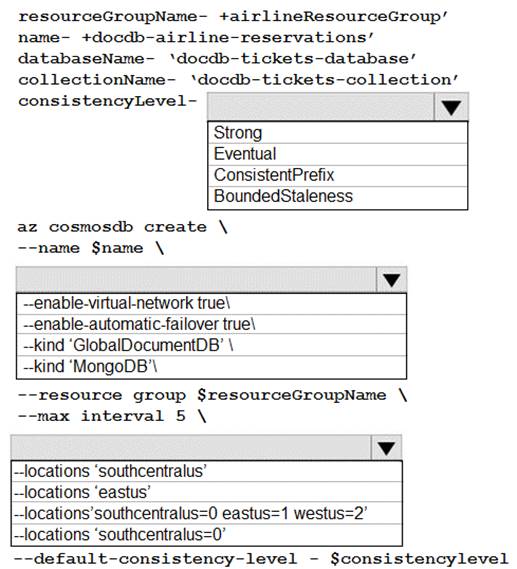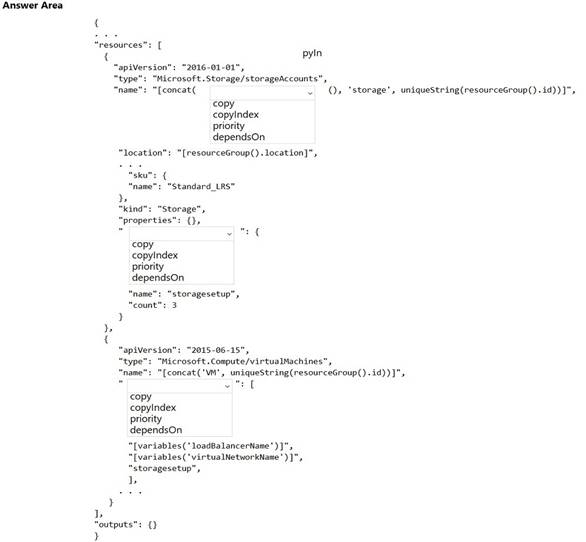HOTSPOT - (Topic 8)
You are developing a ticket reservation system for an airline.
The storage solution for the application must meet the following requirements:
✑ Ensure at least 99.99% availability and provide low latency.
✑ Accept reservations event when localized network outages or other unforeseen failures occur.
✑ Process reservations in the exact sequence as reservations are submitted to minimize overbooking or selling the same seat to multiple travelers.
✑ Allow simultaneous and out-of-order reservations with a maximum five-second tolerance window.
You provision a resource group named airlineResourceGroup in the Azure South-Central US region.
You need to provision a SQL SPI Cosmos DB account to support the app.
How should you complete the Azure CLI commands? To answer, select the appropriate options in the answer area.
NOTE:Each correct selection is worth one point.
Solution:
Box 1: BoundedStaleness
Bounded staleness: The reads are guaranteed to honor the consistent-prefix guarantee. The reads might lag behind writes by at most "K" versions (that is, "updates") of an item or by "T" time interval. In other words, when you choose bounded staleness, the "staleness" can be configured in two ways:
The number of versions (K) of the item
The time interval (T) by which the reads might lag behind the writes
Does this meet the goal?
Correct Answer:
A
- (Topic 8)
Note: This question is part of a series of questions that present the same scenario. Each question in the series contains a unique solution that might meet the stated goals. Some question sets might have more than one correct solution, while others might not have a correct solution.
After you answer a question in this section, you will NOT be able to return to it. As a result, these questions will not appear in the review screen.
You develop an HTTP triggered Azure Function app to process Azure Storage blob data. The app is triggered using an output binding on the blob.
The app continues to time out after four minutes. The app must process the blob data. You need to ensure the app does not time out and processes the blob data.
Solution: Configure the app to use an App Service hosting plan and enable the Always On setting.
Does the solution meet the goal?
Correct Answer:
B
Instead pass the HTTP trigger payload into an Azure Service Bus queue to be processed by a queue trigger function and return an immediate HTTP success response.
Note: Large, long-running functions can cause unexpected timeout issues. General best practices include:
Whenever possible, refactor large functions into smaller function sets that work together and return responses fast. For example, a webhook or HTTP trigger function might require an acknowledgment response within a certain time limit; it's common for webhooks to require an immediate response. You can pass the HTTP trigger payload into a queue to be processed by a queue trigger function. This approach lets you defer the actual work and return an immediate response.
Reference:
https://docs.microsoft.com/en-us/azure/azure-functions/functions-best-practices
HOTSPOT - (Topic 8)
You are configuring a new development environment for a Java application.
The environment requires a Virtual Machine Scale Set (VMSS), several storage accounts, and networking components.
The VMSS must not be created until the storage accounts have been successfully created and an associated load balancer and virtual network is configured.
How should you complete the Azure Resource Manager template? To answer, select the appropriate options in the answer area.
NOTE:Each correct selection is worth one point.
Solution:
Box 1: copyIndex
Notice that the name of each resource includes the copyIndex() function, which returns the current iteration in the loop. copyIndex() is zero-based.
Box 2: copy
By adding the copy element to the resources section of your template, you can dynamically set the number of resources to deploy.
Box 3: dependsOn Example:
"type": "Microsoft.Compute/virtualMachineScaleSets", "apiVersion": "2020-06-01",
"name": "[variables('namingInfix')]",
"location": "[parameters('location')]", "sku": {
"name": "[parameters('vmSku')]", "tier": "Standard",
"capacity": "[parameters('instanceCount')]"
},
"dependsOn": [
"[resourceId('Microsoft.Network/loadBalancers', variables('loadBalancerName'))]", "[resourceId('Microsoft.Network/virtualNetworks', variables('virtualNetworkName'))]"
],
Does this meet the goal?
Correct Answer:
A
- (Topic 2)
You need to deploy the CheckUserContent Azure function. The solution must meet the security and cost requirements.
Which hosting model should you use?
Correct Answer:
C
HOTSPOT - (Topic 1)
You need to secure the Shipping Function app.
How should you configure the app? To answer, select the appropriate options in the answer area.
NOTE: Each correct selection is worth one point.
Solution:
Scenario: Shipping Function app: Implement secure function endpoints by using app-level security and include Azure Active Directory (Azure AD).
Box 1: Function
Box 2: JSON based Token (JWT)
Azure AD uses JSON based tokens (JWTs) that contain claims
Box 3: HTTP
How a web app delegates sign-in to Azure AD and obtains a token
User authentication happens via the browser. The OpenID protocol uses standard HTTP protocol messages.
References:
https://docs.microsoft.com/en-us/azure/active-directory/develop/authentication-scenarios
Does this meet the goal?
Correct Answer:
A

